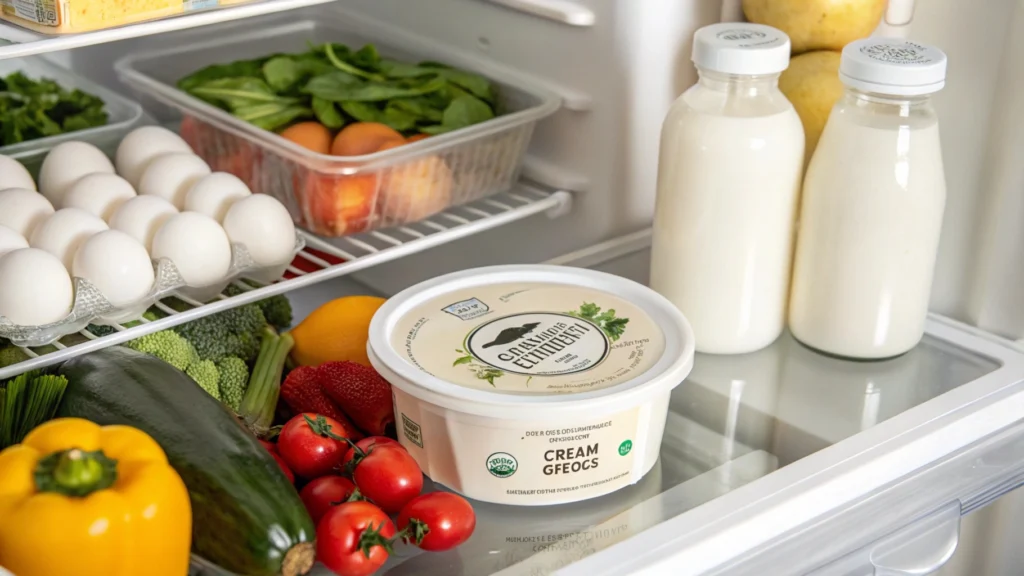When it comes to versatile ingredients in the kitchen, few can compete with the creamy, tangy goodness of cream cheese. This beloved dairy product is a staple in households worldwide, making its way into everything from breakfast bagels to decadent desserts. But what exactly is cream cheese? Where did it originate, and why is it such a popular choice?
actic acid bacteria work their magic. The result is a cheese that is flavorful without being overwhelming, allowing it to complement a wide variety of dishes.
Key Ingredients in Cream Cheese
The magic of cream cheese lies in its simple yet effective ingredients:
- Dairy Base: A mix of cream and milk for that rich, creamy foundation.
- Lactic Acid: Naturally present during fermentation, this gives cream cheese its tangy flavor.
- Salt: Used sparingly to enhance the taste.
- Optional Additives: Many brands use stabilizers like locust bean gum or guar gum to maintain a consistent texture.
Homemade versions of cream cheese typically skip the stabilizers, offering a purer and more natural product. However, they require careful handling to ensure food safety.
Popular Recipes Using Cream Cheese
Cream cheese is a culinary powerhouse, enhancing everything from breakfasts to desserts. Its creamy texture and mild tang make it an adaptable ingredient that shines in both sweet and savory dishes. Here are some classic recipes where cream cheese takes center stage:

Cream Cheese Frosting
One of the most beloved uses of cream cheese is in frosting, particularly for carrot cakes, red velvet cakes, and cinnamon rolls.
- Ingredients: Cream cheese, butter, powdered sugar, and vanilla extract.
- Preparation: Beat the cream cheese and butter until smooth, then gradually add powdered sugar and vanilla extract. The result is a rich, creamy frosting that balances sweetness with a slight tang.
Cheesecake Delight
A staple dessert for cream cheese enthusiasts, cheesecake’s smooth and decadent texture is unmatched.
- Ingredients: Cream cheese, sugar, eggs, vanilla, and a graham cracker crust.
- Preparation: Blend cream cheese with sugar and eggs to create a velvety batter, then bake it atop a graham cracker crust. Variations include fruit toppings, chocolate swirls, or even no-bake options for simplicity.
Dips and Spreads
Cream cheese transforms into delightful dips for parties or snacks.
- Spinach Artichoke Dip: Mix cream cheese with spinach, artichokes, garlic, and parmesan for a hot, bubbly appetizer.
- Buffalo Chicken Dip: Combine cream cheese with shredded chicken, buffalo sauce, and cheddar for a spicy, creamy snack.
Cream Cheese in Savory Dishes
While often associated with sweet recipes, cream cheese also plays a pivotal role in savory dishes, adding richness and depth to flavors.
Stuffed Vegetables
Cream cheese is often used as a filling for stuffed bell peppers, mushrooms, or jalapeños. When mixed with herbs, spices, and shredded cheese, it creates a creamy, savory stuffing that pairs well with the vegetables’ natural flavors.
Soups and Sauces
Adding a dollop of cream cheese to soups like tomato bisque or creamy chicken noodle elevates the texture and flavor. Similarly, cream cheese can thicken and enrich pasta sauces, making dishes like creamy Alfredo or baked ziti irresistible.
Savory Pastries
In savory pastries, such as puff pastry pinwheels or empanadas, cream cheese provides a creamy filling base. Mix it with ingredients like smoked salmon, sun-dried tomatoes, or spinach for a sophisticated touch.
Cream Cheese in Baking: Tips and Tricks
Baking with cream cheese requires a few key tips to ensure success:
- Room Temperature: Always bring cream cheese to room temperature before mixing to avoid lumps.
- Avoid Overmixing: When making batters like cheesecake, overmixing can incorporate too much air, leading to cracks during baking.
- Use Full-Fat Cream Cheese: For the best results in baked goods, full-fat cream cheese provides the ideal texture and flavor.
Creative Baking Ideas
- Cream Cheese Brownies: Swirl cream cheese into brownie batter for a marbled effect.
- Danish Pastries: Use cream cheese as a filling for flaky Danish pastries, topped with fruit preserves.
- Savory Scones: Add small chunks of cream cheese to savory scone dough for pockets of creamy goodness.
How to Store Cream Cheese Properly
Proper storage is essential for maintaining the freshness, flavor, and safety of cream cheese. Whether you’re dealing with a freshly opened package or leftovers from a recipe, following these guidelines will ensure your cream cheese stays in top condition.

Refrigeration
- Ideal Temperature: Always store cream cheese in the refrigerator at a temperature below 40°F (4°C).
- Keep It Sealed: After opening, ensure the package is tightly sealed or transfer the cream cheese to an airtight container to prevent it from drying out or absorbing odors from other foods.
Freezing Cream Cheese
While cream cheese can technically be frozen, it’s not always ideal. Freezing can alter its texture, making it grainy or less creamy upon thawing. However, frozen cream cheese works well in recipes like baked goods where texture is less critical.
- Freezing Guidelines:
- Wrap the cream cheese tightly in plastic wrap or aluminum foil.
- Place it in a freezer-safe bag or container.
- Label with the date and use within two months for best quality.
- Thawing Tips: Thaw frozen cream cheese in the refrigerator overnight and stir well before use to smooth out any graininess.
Signs Your Cream Cheese Has Gone Bad
To ensure safety and quality, it’s important to recognize the signs of spoiled cream cheese. Here are some key indicators that your cream cheese is no longer good to use:
- Discoloration: If you notice any yellowing or the appearance of mold, discard the cream cheese immediately.
- Unpleasant Odor: Fresh cream cheese has a mild, tangy scent. A sour or off-putting smell is a clear sign of spoilage.
- Texture Changes: If the cream cheese becomes excessively watery or develops a slimy texture, it’s time to throw it out.
- Off Taste: If everything else seems fine but the cream cheese tastes sour or bitter, it’s best not to consume it.
General Shelf Life Guidelines
- Unopened Cream Cheese: Can last up to one month past the expiration date if kept refrigerated.
- Opened Cream Cheese: Should be consumed within 7-10 days for optimal freshness.
- Homemade Cream Cheese: Usually has a shorter shelf life of about 5-7 days due to the lack of preservatives.
Tips for Maximizing Freshness
- Always use a clean utensil when scooping cream cheese to prevent contamination.
- Store cream cheese in the coldest part of your refrigerator (avoid the door, as temperatures can fluctuate).
- Avoid leaving cream cheese out at room temperature for extended periods, especially during warm weather.
Cream Cheese Alternatives for Health-Conscious Consumers
While cream cheese is a rich and delicious ingredient, its high fat and calorie content might not fit every diet. Fortunately, there are plenty of healthier alternatives that deliver similar creaminess and flavor without compromising your nutritional goals.
1. Low-Fat Cream Cheese
Most major brands offer reduced-fat or “light” versions of cream cheese, which have fewer calories and less saturated fat while maintaining the creamy texture and tangy taste.
- Nutritional Benefits: Lower in fat and calories compared to regular cream cheese.
- Best For: Spreads and dips.
2. Greek Yogurt Cream Cheese
Greek yogurt-based cream cheese is an excellent alternative, providing a protein-rich option with fewer calories.
- Nutritional Benefits: High in protein, low in fat, and contains probiotics for gut health.
- Best For: Spreads, dips, and baked goods.
3. Vegan Cream Cheese
For those avoiding dairy, vegan cream cheese is a great option. It’s typically made from plant-based ingredients like almond, cashew, or soy.
- Nutritional Benefits: Cholesterol-free and suitable for those with lactose intolerance or following a vegan diet.
- Best For: Spreads and recipes where cream cheese is not the central ingredient.
4. Cottage Cheese and Ricotta
Blending cottage cheese or ricotta with a splash of milk or cream can create a smooth, spreadable texture similar to cream cheese.
- Nutritional Benefits: Lower in calories and higher in protein.
- Best For: Baking and savory dishes.
Is Cream Cheese Gluten-Free?
For those with gluten sensitivities or celiac disease, cream cheese is generally considered safe. Here’s what you need to know:
Naturally Gluten-Free
Cream cheese in its pure form made from milk, cream, and salt is gluten-free. The production process does not involve any gluten-containing ingredients.
Check Flavored Varieties
Some flavored or processed cream cheese products may contain additives or flavorings that could include gluten. Always check the label for a “gluten-free” certification or scrutinize the ingredient list for potential allergens.
Safe Options for Gluten-Free Diets
Stick to trusted brands that explicitly label their products as gluten-free. Pair cream cheese with gluten-free bread, bagels, or crackers to ensure a safe and satisfying snack.
Benefits for Specific Diets
Keto-Friendly Option
Cream cheese is a favorite among those following a ketogenic diet due to its low carbohydrate content. With nearly zero carbs and high fat, it fits perfectly into the macros of a keto lifestyle.
Pregnancy-Safe
Cream cheese is safe for pregnant women as long as it is made from pasteurized milk, which eliminates harmful bacteria like Listeria. Always verify the label to ensure pasteurization.
Fun Facts About Cream Cheese
Cream cheese might seem like a simple ingredient, but it’s surrounded by fascinating trivia that highlights its global appeal and versatility.
1. Accidental Creation
Cream cheese was invented accidentally in 1872 by William Lawrence, a New York dairyman trying to recreate the French cheese Neufchâtel. His happy mistake gave the world a brand-new type of cheese!
2. Philadelphia Cream Cheese Is Not from Philadelphia
Despite the iconic brand name, Philadelphia Cream Cheese originated in New York. The name was chosen to evoke the quality and richness associated with Philadelphia dairy products in the 19th century.
3. World’s Largest Cheesecake
The largest cheesecake ever made weighed over 4,000 pounds and was created in Mexico City in 2009. The recipe, of course, called for an enormous amount of cream cheese!
4. Popular in Sushi
In Japanese cuisine, cream cheese has found its way into fusion-style sushi rolls, like the Philadelphia Roll, which combines salmon and cream cheese.
5. A Bagel’s Best Friend
Cream cheese and bagels are an iconic duo in American food culture. This pairing became a staple in New York City and quickly spread nationwide.
Cream Cheese in Popular Culture and Traditions
In Baking Competitions
Cream cheese is a star ingredient in baking shows and competitions, particularly in recipes for cheesecakes, frostings, and pastries. Its versatility makes it a favorite among contestants.
Holiday Traditions
Cream cheese often makes an appearance during holidays. From frosted cookies to creamy dips, it’s a key ingredient in festive recipes worldwide.
Pop Culture References
The mention of cream cheese in sitcoms, movies, and advertisements often highlights its association with comfort foods like bagels and cheesecakes. For example, references to cream cheese in popular media frequently emphasize its indulgent nature.

